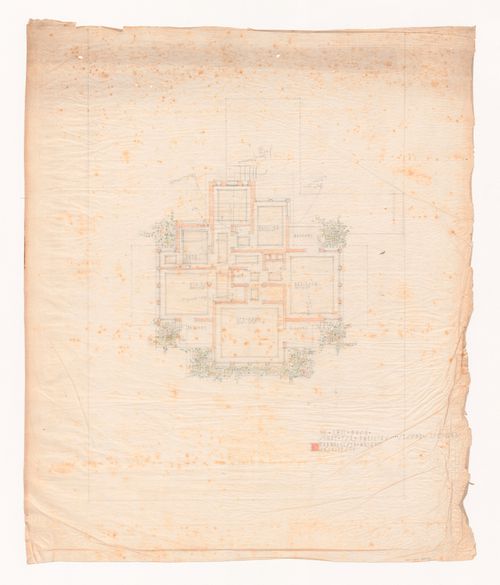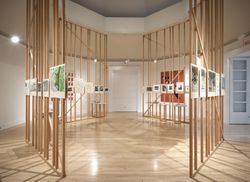archives
Level of archival description:
Fonds
AP177
Synopsis:
The RUR Architecture Kansai-kan of the National Diet Library project records, circa 1996, document the New York based firm’s competition entry for the Kansai Science City branch of Japan’s National Diet Library. Records show integration of landscape in the building’s design, exploration of the relationship between structure and surface, and a multimedia approach to building design. Records include 169 digital files, mostly CAD models and images; 42 drawings and printed renderings; and 5 models and casts.
1996-2015
RUR Architecture Kansai-kan of the National Diet Library project records
Actions:
AP177
Synopsis:
The RUR Architecture Kansai-kan of the National Diet Library project records, circa 1996, document the New York based firm’s competition entry for the Kansai Science City branch of Japan’s National Diet Library. Records show integration of landscape in the building’s design, exploration of the relationship between structure and surface, and a multimedia approach to building design. Records include 169 digital files, mostly CAD models and images; 42 drawings and printed renderings; and 5 models and casts.
archives
Level of archival description:
Fonds
1996-2015
DR1980:0060:003
Description:
- This plan, with the perspective (DR1980:0060:001) and the first floor plan (DR1980:0060:002), forms a set of early presentation drawings. The scale is probably 1/4" = 1' (see object file, de Long report). Comparing this drawing with the plan reproduced in Hitchcock, an additional staircase leading to a (here non-existent) terrace has been added behind the stairwell. The closet for the right bedroom has been changed, and the bathroom "nook" has been assigned to the left bedroom in the Hitchcock plan. Doors do not yet appear.
architecture
1915
Second floor plan for Emil Bach House, Chicago, Illinois
Actions:
DR1980:0060:003
Description:
- This plan, with the perspective (DR1980:0060:001) and the first floor plan (DR1980:0060:002), forms a set of early presentation drawings. The scale is probably 1/4" = 1' (see object file, de Long report). Comparing this drawing with the plan reproduced in Hitchcock, an additional staircase leading to a (here non-existent) terrace has been added behind the stairwell. The closet for the right bedroom has been changed, and the bathroom "nook" has been assigned to the left bedroom in the Hitchcock plan. Doors do not yet appear.
architecture
DR1990:0057
Description:
- This watercolour rendering depicts a welcome arch composed of a large central barrel vaulted archway which spans the street, with a lower parallel barrel vaulted archway over the sidewalks at each side. The central archway is surmounted by a dome on a drum and the entire structure is supported by four rows of columns. The arch is embellished with Gothic-inspired features such as blind tracery and pointed arches as well as shields, including two inscribed with the letter "L", flags, floral garlands, the British royal coat of arms, and possibly lights. Staffage indicates the large scale of the arch.
temporary architecture
16 May 1879
Perspective for a temporary welcome arch at the intersection of King and Yonge Streets for the visit of the Marquess of Lorne and Princess Louise to Toronto, September 1879
Actions:
DR1990:0057
Description:
- This watercolour rendering depicts a welcome arch composed of a large central barrel vaulted archway which spans the street, with a lower parallel barrel vaulted archway over the sidewalks at each side. The central archway is surmounted by a dome on a drum and the entire structure is supported by four rows of columns. The arch is embellished with Gothic-inspired features such as blind tracery and pointed arches as well as shields, including two inscribed with the letter "L", flags, floral garlands, the British royal coat of arms, and possibly lights. Staffage indicates the large scale of the arch.
temporary architecture
archives
Level of archival description:
Fonds
AP113
Synopsis:
The Illinois Institute of Technology (IIT) - New Campus Center Competition fonds documents the projects of 4 of the 5 finalists (Eisenman, Hadid, Jahn/Sobek and Sejima/Nishizawa) of the international competition Richard H. Driehaus Foundation Design Competition for the University’s New Campus Center held by the Illinois Institute of Technology (IIT) of Chicago in November 1996. The fonds contains 20 presentation panels and 7 models. _____________________ Le Illinois Institute of Technology (IIT) - New Campus Center Competition fonds documentent les projets soumis par 4 des 5 finalistes (Eisenman, Hadid, Jahn/Sobek et Sejima/Nishizawa) au concours international Richard H. Driehaus Foundation Design Competition for the University’s New Campus Center lancé par l’Illinois Institute of Technology (IIT) de Chicago en novembre 1996. Le fonds contient 20 panneaux de présentation et 7 maquettes.
[1997]-1998
IIT - New Campus Center Competition fonds
Actions:
AP113
Synopsis:
The Illinois Institute of Technology (IIT) - New Campus Center Competition fonds documents the projects of 4 of the 5 finalists (Eisenman, Hadid, Jahn/Sobek and Sejima/Nishizawa) of the international competition Richard H. Driehaus Foundation Design Competition for the University’s New Campus Center held by the Illinois Institute of Technology (IIT) of Chicago in November 1996. The fonds contains 20 presentation panels and 7 models. _____________________ Le Illinois Institute of Technology (IIT) - New Campus Center Competition fonds documentent les projets soumis par 4 des 5 finalistes (Eisenman, Hadid, Jahn/Sobek et Sejima/Nishizawa) au concours international Richard H. Driehaus Foundation Design Competition for the University’s New Campus Center lancé par l’Illinois Institute of Technology (IIT) de Chicago en novembre 1996. Le fonds contient 20 panneaux de présentation et 7 maquettes.
archives
Level of archival description:
Fonds
[1997]-1998
First, the Forests
*First, the Forests* examines some unexplored relationships between forestry, planning, and design. Reframing forestry as an activity that creates highly designed environments with unprecedented scale, ambition and precision, the exhibition proposes an expanded understanding of the connections between natural resources, production processes, and designed form. Curated(...)
Octagonal gallery
4 October 2012 to 6 January 2013
First, the Forests
Actions:
Description:
*First, the Forests* examines some unexplored relationships between forestry, planning, and design. Reframing forestry as an activity that creates highly designed environments with unprecedented scale, ambition and precision, the exhibition proposes an expanded understanding of the connections between natural resources, production processes, and designed form. Curated(...)
Octagonal gallery
Chèques Postaux - 1930
PH1986:0900.09
Description:
Album PH1986:0900.09 comprises 119 photographs of a post-office located on the Rue d'Alleray, Rue des Favorites and Rue Bourseul, Paris, France, designed by Michel Roux-Spitz. The building featured in the album is identified on one of the photographs as "Poste télégraphe - Téléphone - Bureau central du XVe arrondissement". Photographs show exterior and interior views of the post-office including the inner court, roof, several views of a scale model of the building, the post-office counter, set of shelves (the stacks), hallways, staircase, kitchen, cafeteria, boiler room, utility room and views of the post office's surroundings.
architecture, interior design
1930
Chèques Postaux - 1930
Actions:
PH1986:0900.09
Description:
Album PH1986:0900.09 comprises 119 photographs of a post-office located on the Rue d'Alleray, Rue des Favorites and Rue Bourseul, Paris, France, designed by Michel Roux-Spitz. The building featured in the album is identified on one of the photographs as "Poste télégraphe - Téléphone - Bureau central du XVe arrondissement". Photographs show exterior and interior views of the post-office including the inner court, roof, several views of a scale model of the building, the post-office counter, set of shelves (the stacks), hallways, staircase, kitchen, cafeteria, boiler room, utility room and views of the post office's surroundings.
1930
architecture, interior design
archives
Level of archival description:
Fonds
Bernard Cache fonds
AP169
Synopsis:
Bernard Cache, fonds, 1991-2011, document the development and design process for the Objectile firm and its decorative panels and furniture. The records focus mostly on daily activities of the firm, the collaboration of principal Bernard Cache with TopSolid software, and his parallel academic work. The records consist solely of original born-digital material.
1992-2011
Bernard Cache fonds
Actions:
AP169
Synopsis:
Bernard Cache, fonds, 1991-2011, document the development and design process for the Objectile firm and its decorative panels and furniture. The records focus mostly on daily activities of the firm, the collaboration of principal Bernard Cache with TopSolid software, and his parallel academic work. The records consist solely of original born-digital material.
archives
Level of archival description:
Fonds
1992-2011
articles
Building a Forest
Forces of Friction
textual records
Bowring Park ARUP 1/2
ARCH253438
Description:
proposals and schemes for new bridge, reprographic copies, sketches, sections, site plans, correspondence, 2 copies of "Association of Consulting Engineers Professional Rules and Practice and Scales of Fees" (1957)
1957-1963
Bowring Park ARUP 1/2
Actions:
ARCH253438
Description:
proposals and schemes for new bridge, reprographic copies, sketches, sections, site plans, correspondence, 2 copies of "Association of Consulting Engineers Professional Rules and Practice and Scales of Fees" (1957)
textual records
1957-1963
textual records
ARCH269223
Description:
Contains correspondence, reports, notes, technical specifications documentation and plans about main control module scales, liquid penetrant inspection, certificate welders and welding procedures, and secondary structure scheme stands.
1998-1999
Correspondence, reports, notes, technical specifications documentation and plans
Actions:
ARCH269223
Description:
Contains correspondence, reports, notes, technical specifications documentation and plans about main control module scales, liquid penetrant inspection, certificate welders and welding procedures, and secondary structure scheme stands.
textual records
1998-1999



